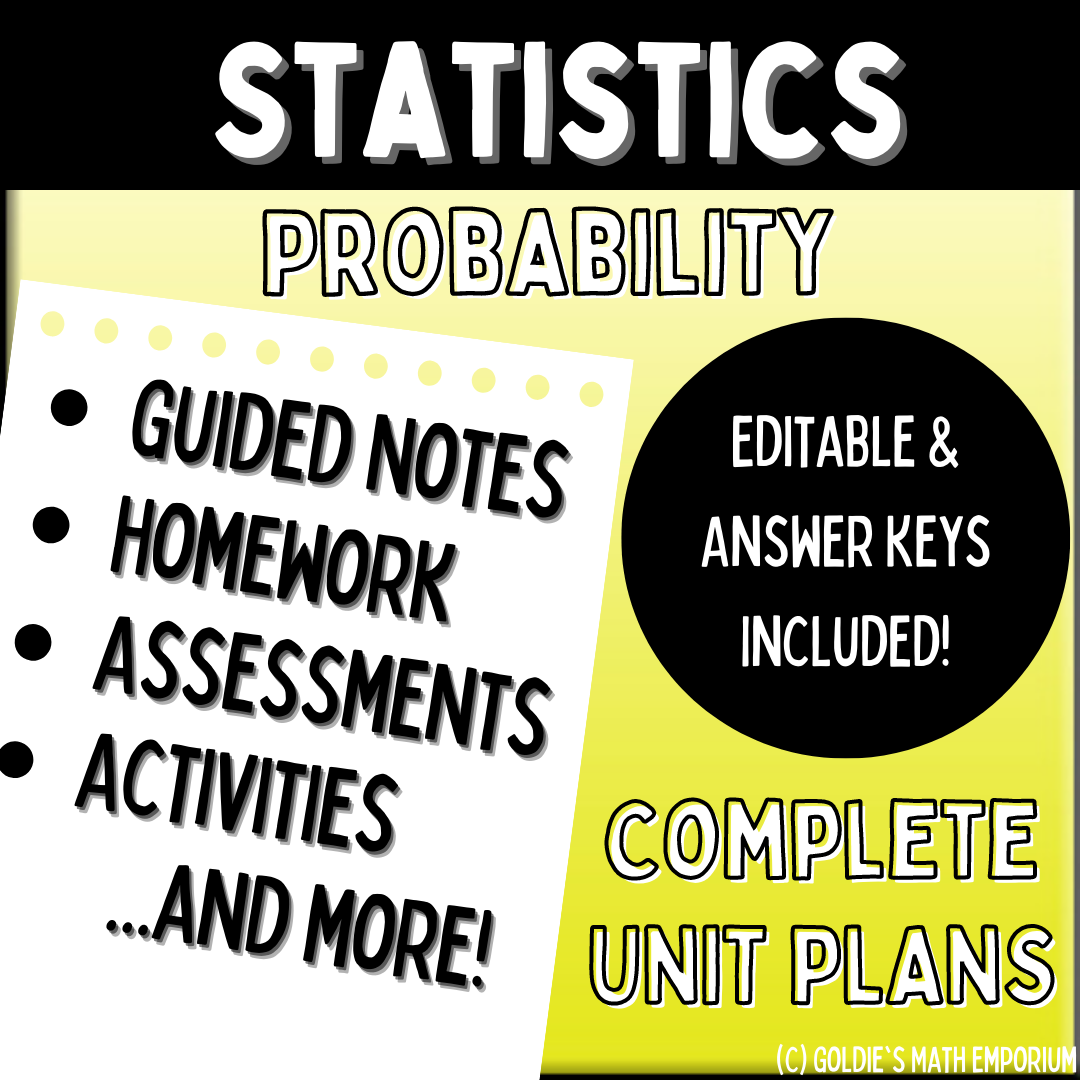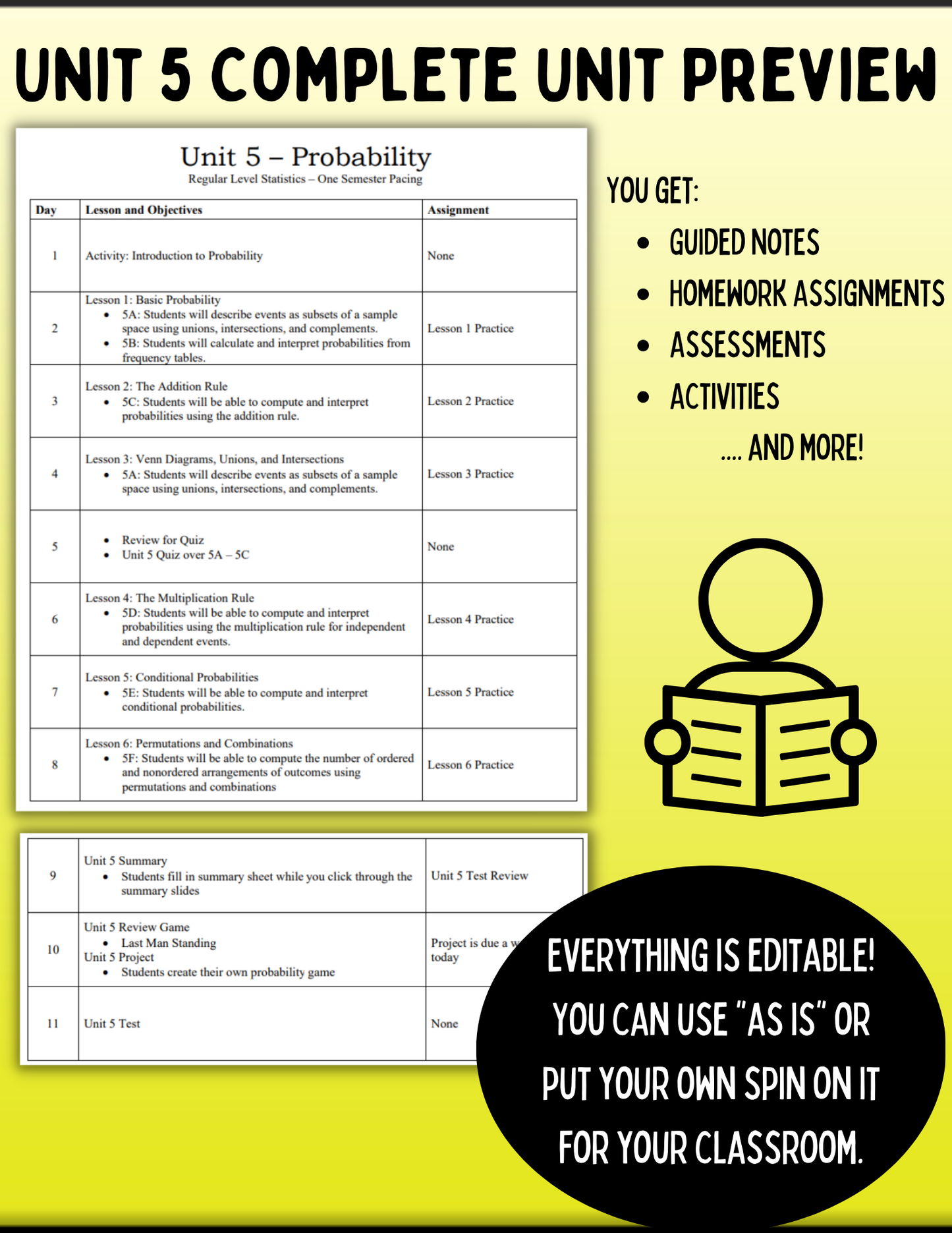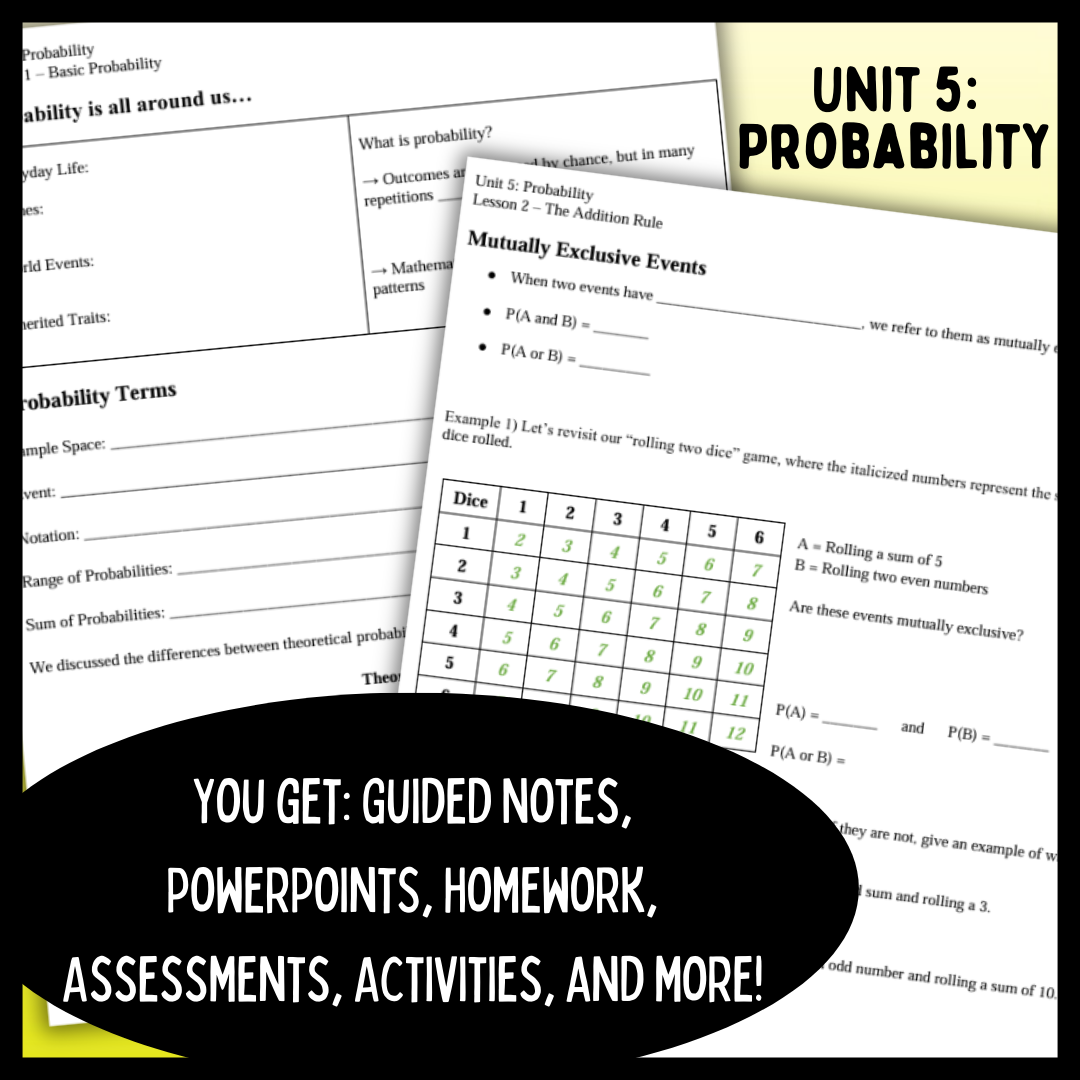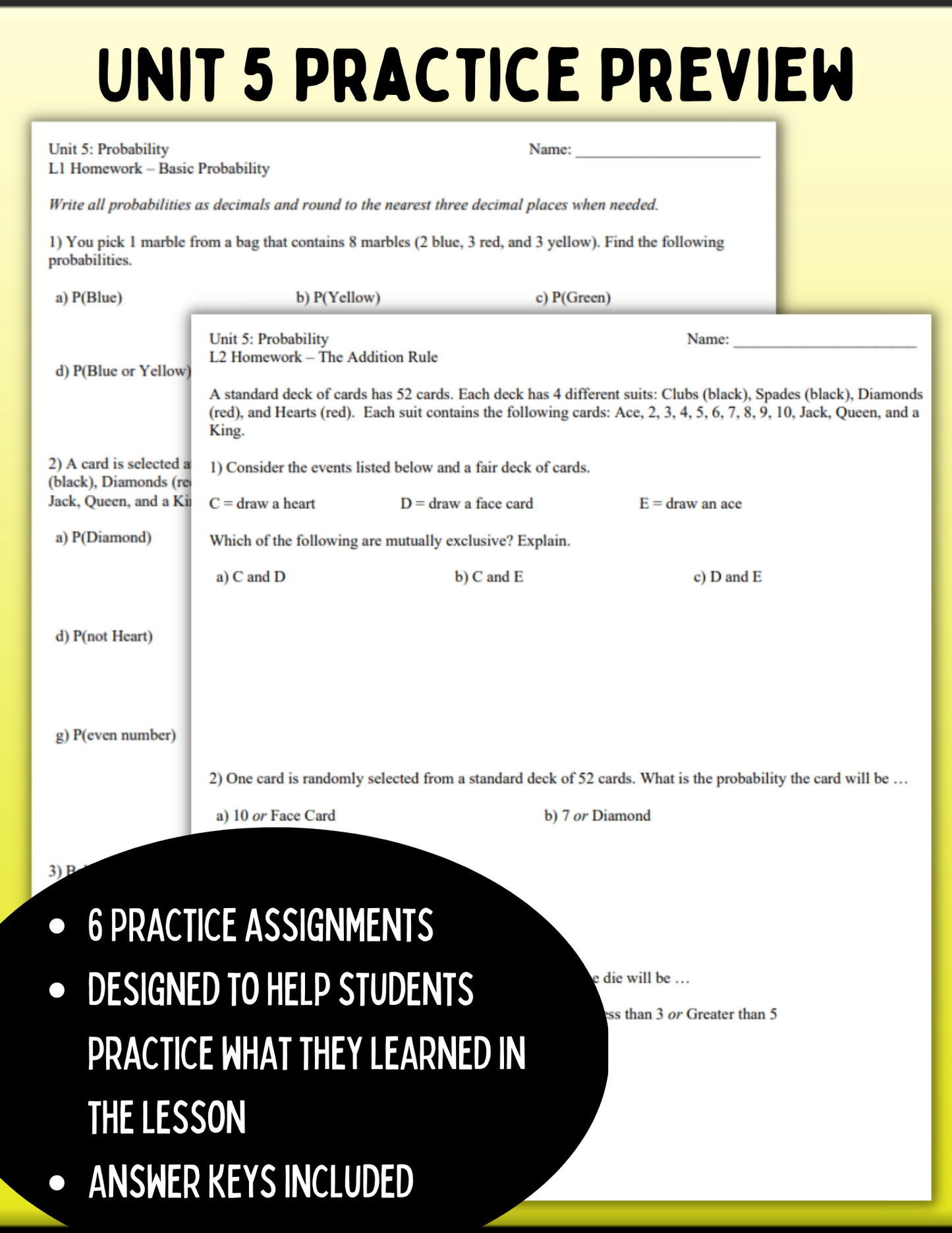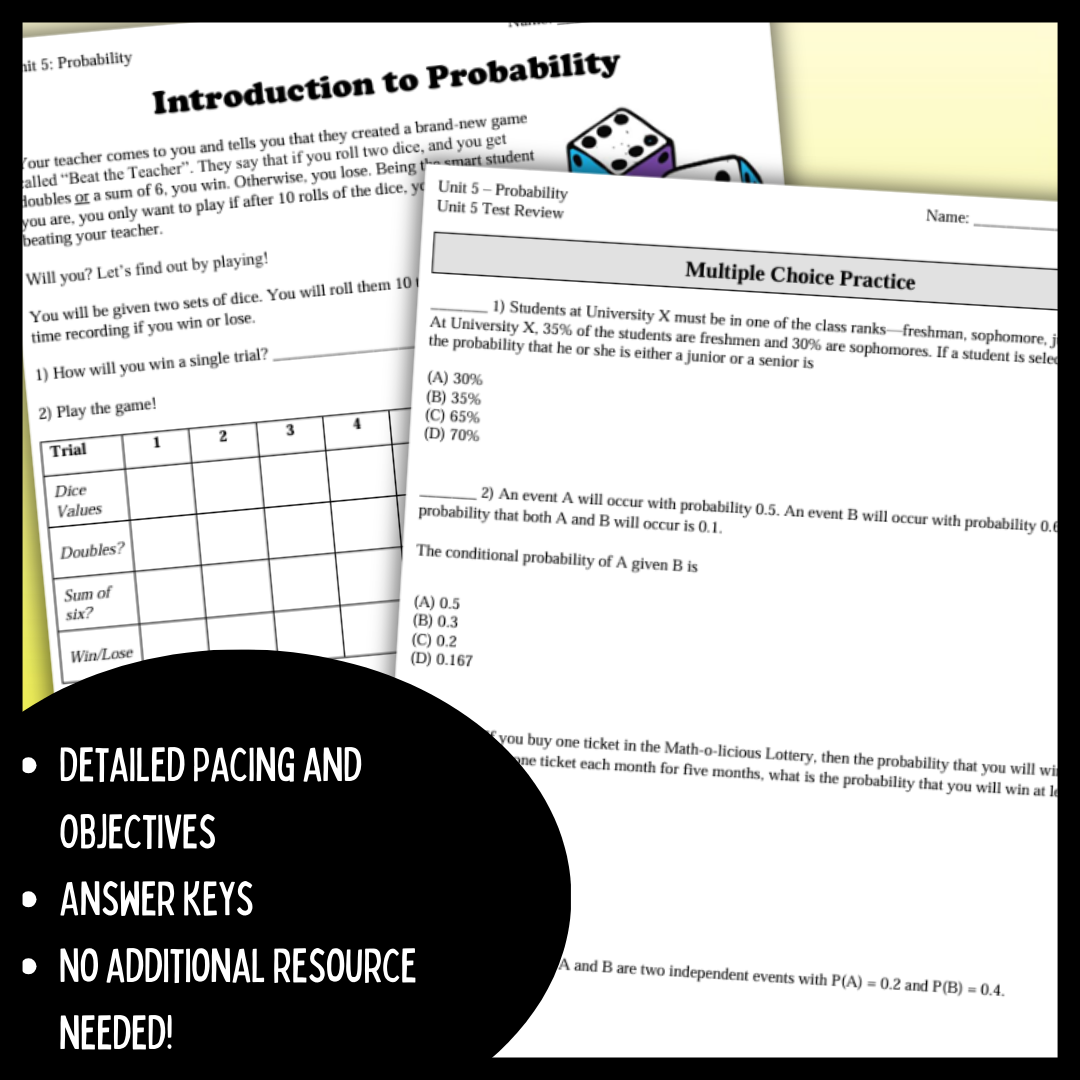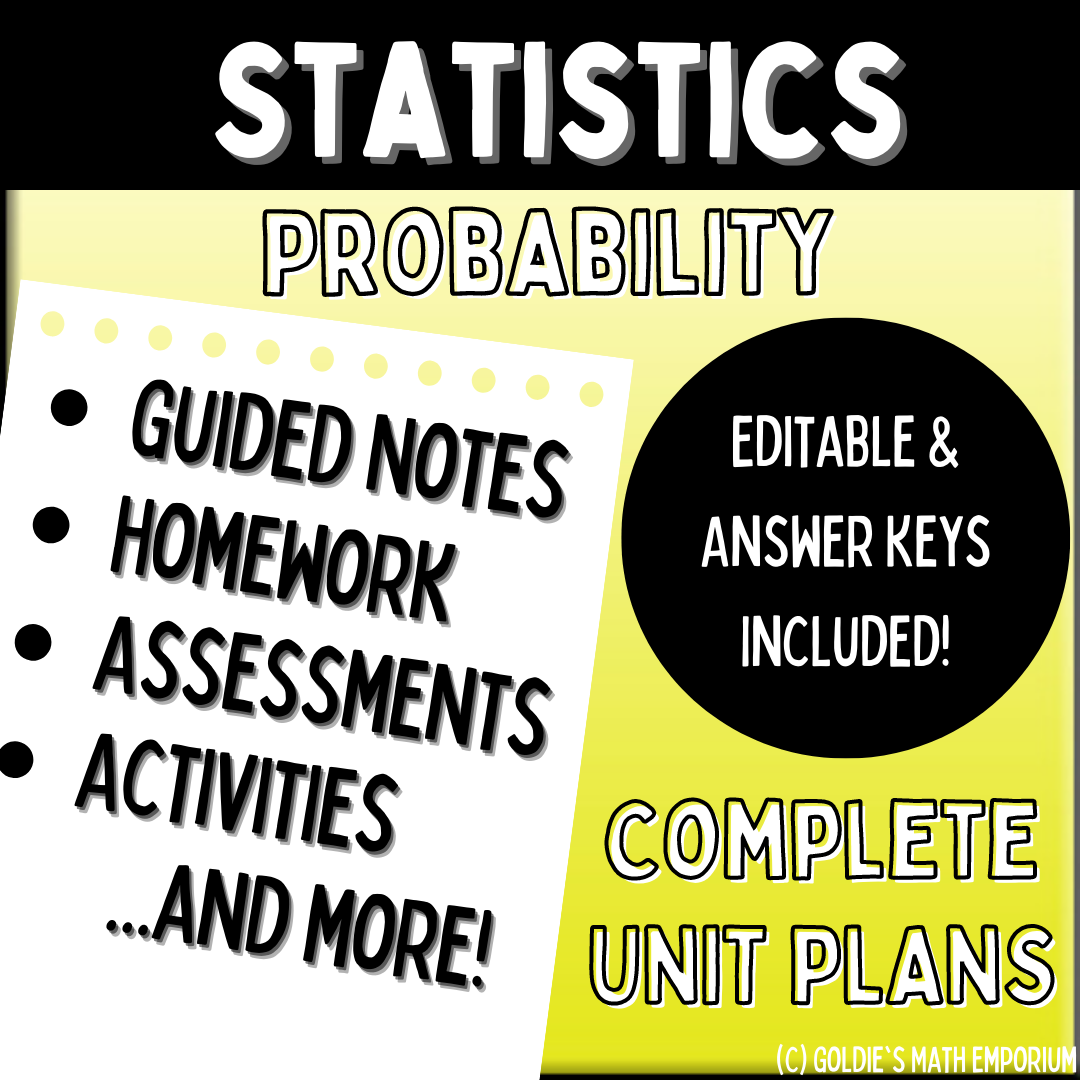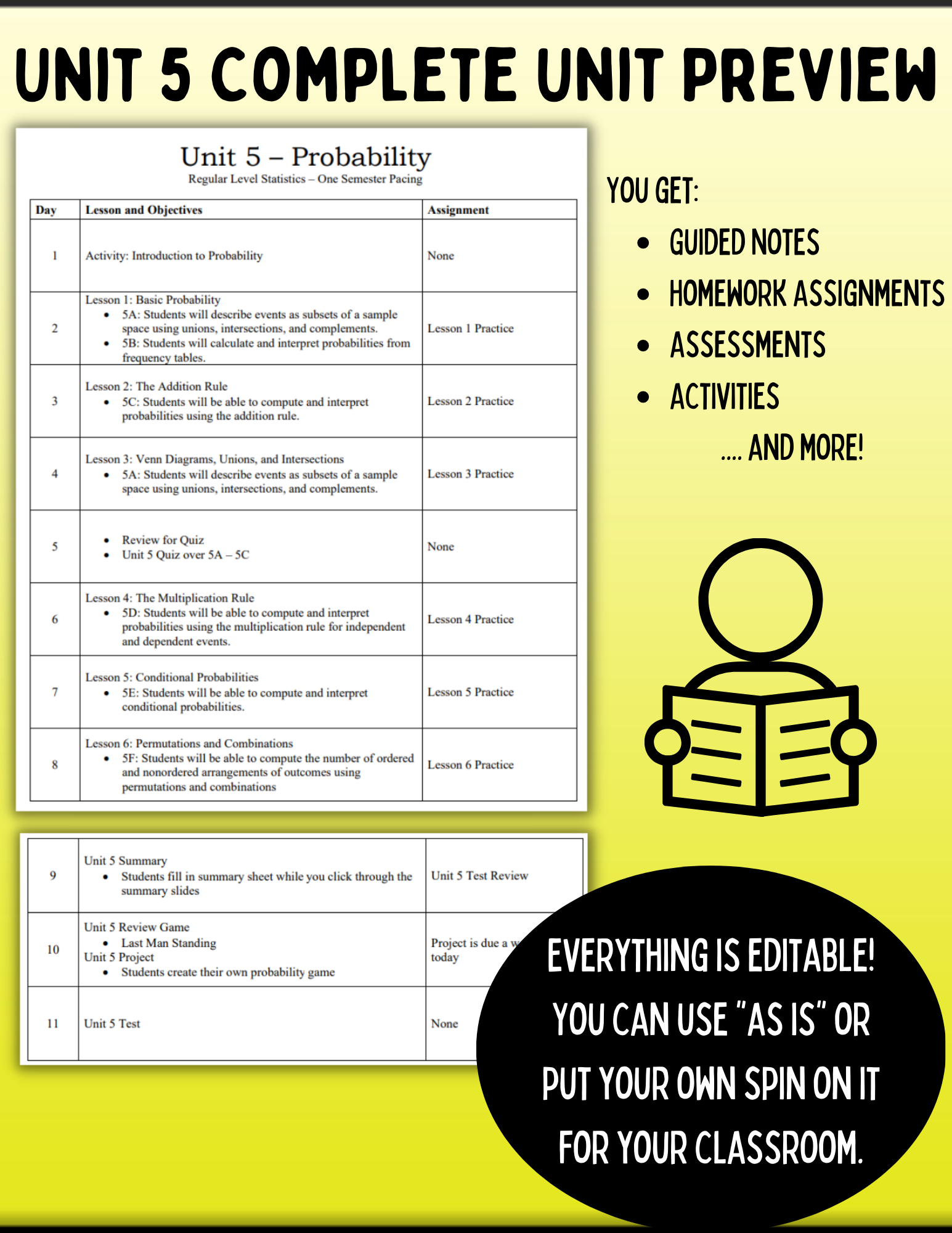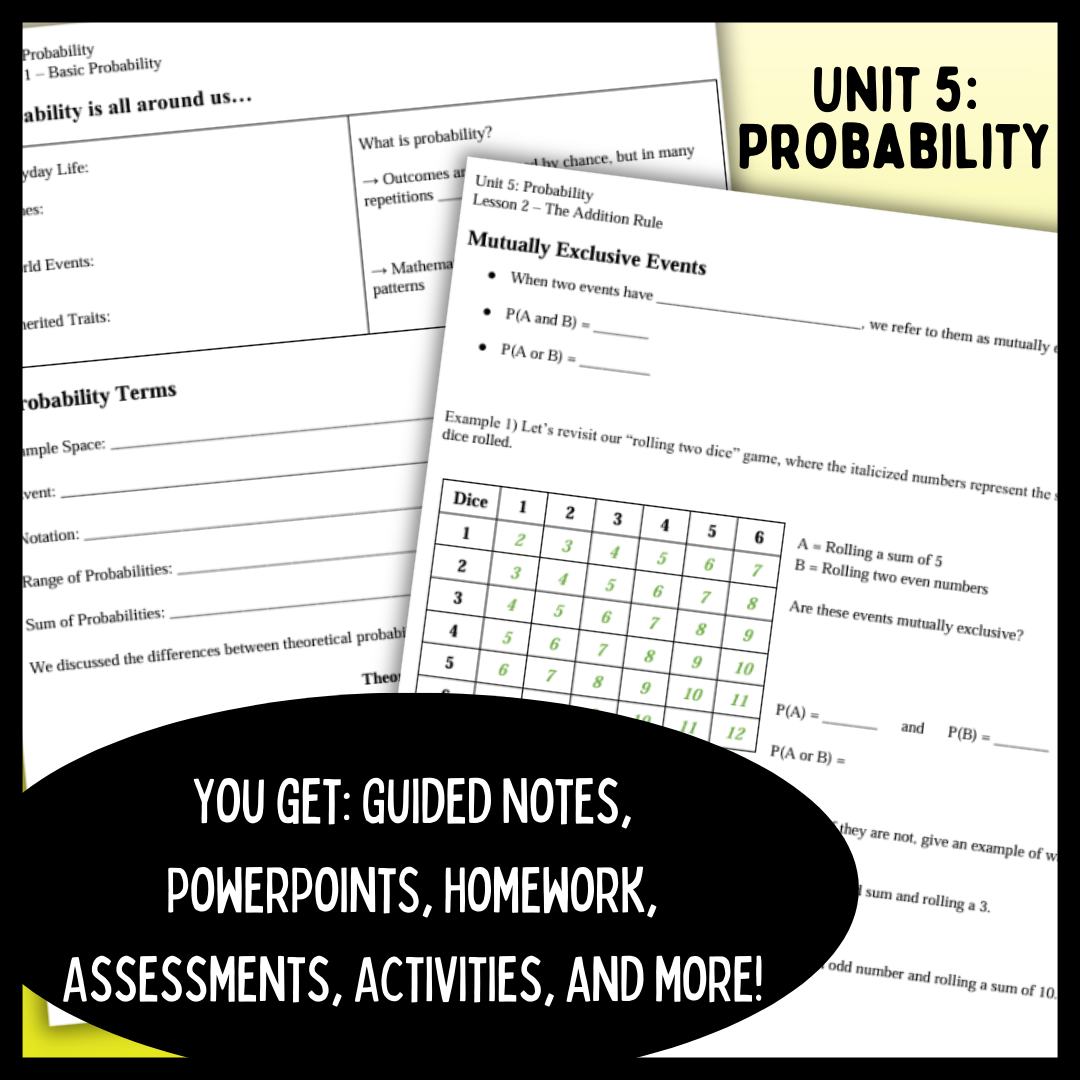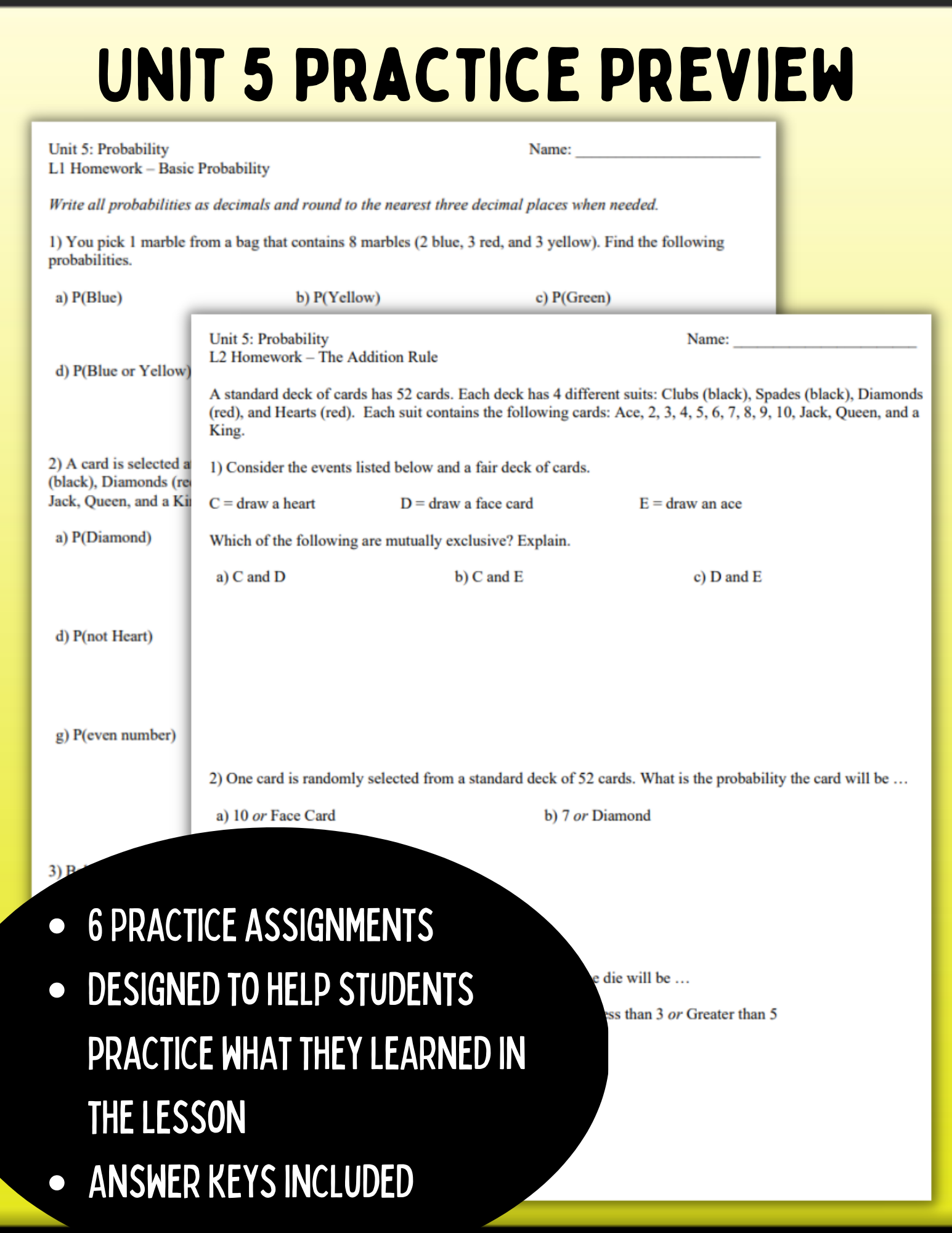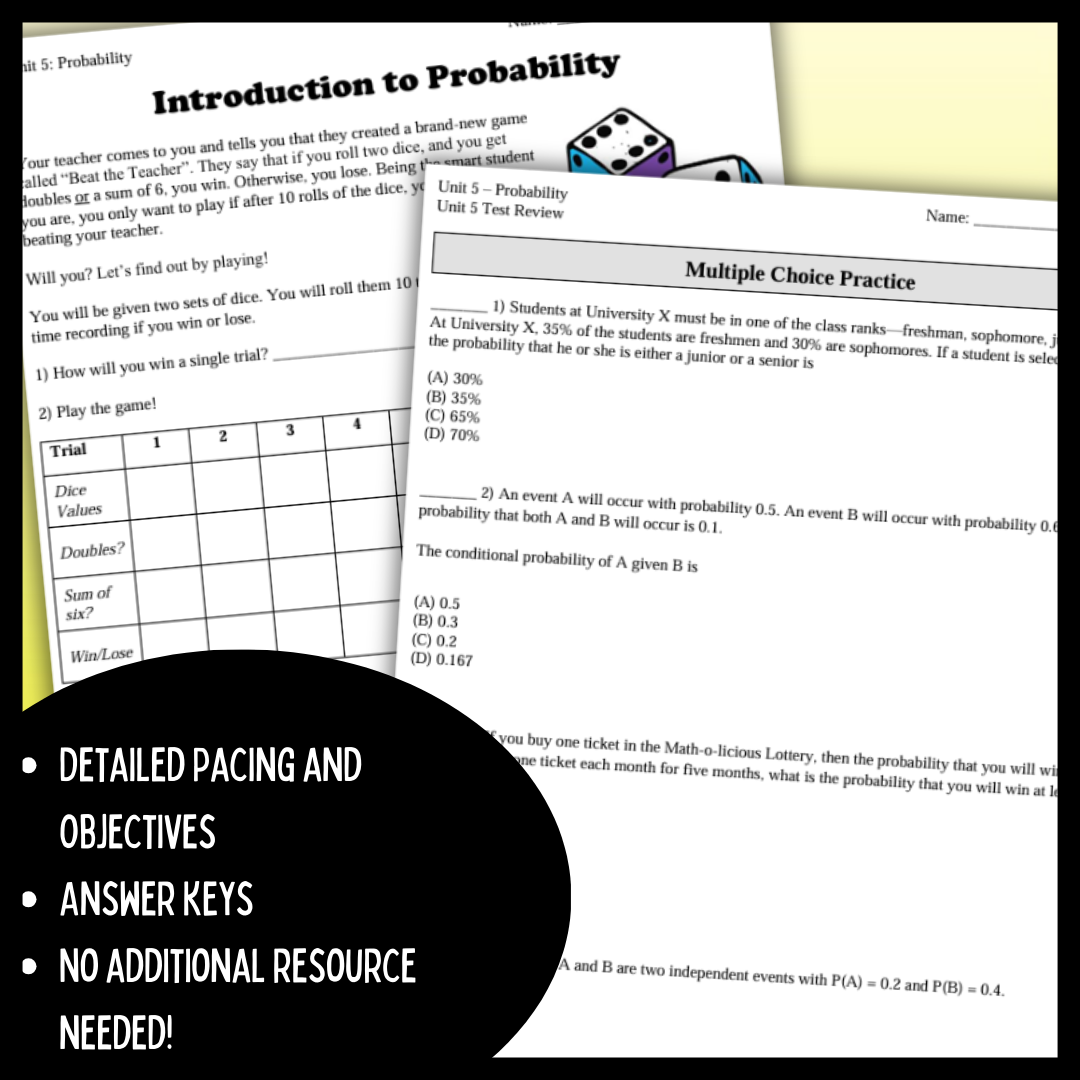Goldie's Math Emporium
Statistics: Probability
Statistics: Probability
Couldn't load pickup availability
Statistics
Unit 5: Probability
Complete Unit Bundle that teaches about probability, conditional probability, permutations, combinations, and more.
Welcome! This is the complete unit plans for the fifth unit in my regular-level Statistics class.
When you purchase this product, you get the following:
- 6 complete sets of student-guided notes (answer keys included)
- PowerPoint slides for each set of notes, for easy classroom instruction
- 6 homework problem sets + complete test review (answer keys included)
- 2 assessments – quiz and test (answer keys included)
- 2 in-class review PowerPoint presentations
- 1 review game – Last Man Standing
- 2 activities
- 1 project
- Suggested pacing and learning targets
All of the resources are 100% editable, to modify to fit your classroom needs. The zip folder includes the Word document, which you have permission to edit completely. The PDF version and answer keys are included for your convenience. There are also PowerPoint presentations for some of the review documents.
I teach this course without a textbook, so everything that is provided here, can be used without supplementation.
*****************************************************************************
The student-friendly learning targets for this unit are:
- Students will describe events as subsets of a sample space using unions, intersections, and complements.
- Students will calculate and interpret probabilities from frequency tables.
- Students will be able to compute and interpret probabilities using the addition rule.
- Students will be able to compute and interpret probabilities using the multiplication rule for independent and dependent events.
- Students will be able to compute and interpret conditional probabilities.
- Students will be able to compute the number of ordered and nonordered arrangements of outcomes using permutations and combinations
The Common Core Math Standards covered in this unit are:
- CP.A.1: Describe events as subsets of a sample space (the set of outcomes) using characteristics (or categories) of the outcomes, or as unions, intersections, or complements of other events ("or," "and," "not").
- CP.A.2: Understand that two events A and B are independent if the probability of A and B occurring together is the product of their probabilities, and use this characterization to determine if they are independent.
- CP.A.3: Understand the conditional probability of A given B as P(A and B)/P(B), and interpret independence of A and B as saying that the conditional probability of A given B is the same as the probability of A, and the conditional probability of B given A is the same as the probability of B.
- CP.A.4: Construct and interpret two-way frequency tables of data when two categories are associated with each object being classified. Use the two-way table as a sample space to decide if events are independent and to approximate conditional probabilities.
- CP.A.5: Recognize and explain the concepts of conditional probability and independence in everyday language and everyday situations.
- CP.B.6: Find the conditional probability of A given B as the fraction of B's outcomes that also belong to A, and interpret the answer in terms of the model.
- CP.B.7: Apply the Addition Rule, P(A or B) = P(A) + P(B) - P(A and B), and interpret the answer in terms of the model.
- CP.B.8: (+) Apply the general Multiplication Rule in a uniform probability model, P(A and B) = P(A)P(B|A) = P(B)P(A|B), and interpret the answer in terms of the model.
- CP.B.9 (+) Use permutations and combinations to compute probabilities of compound events and solve problems.
******************************************************************************
Goldie's Curriculums:
- Statistics: The Complete Curriculum Bundle (Units 1 – 11)
- Statistics: Semester 1 Curriculum Bundle (Units 1 – 6)
- Statistics: Semester 2 Curriculum Bundle (Units 7 – 11)
Goldie's Individual Units:
- Unit 1 – One-Variable Data
- Unit 2 – The Normal Distribution
- Unit 3 – Two-Variable Data
- Unit 4 – Collecting Data
- Unit 5 – Probability
- Unit 6 – Random Variables
- Unit 7 – Sampling Distributions
- Unit 8 – Confidence Intervals
- Unit 9 – Hypothesis Testing
- Unit 10 – Comparing Two Populations
- Unit 11 – Chi-Square Distributions
Goldie's Individual Resources:
- Statistics Semester 1 Assessment Bundle
- Statistics Semester 2 Assessment Bundle
- M&M Statistics Activity Bundle
- Statistics: Semester 1 Final Exam and Study Guide
- Statistics: Semester 2 Final Exam and Study Guide
******************************************************************************
If you need extra explanations or additional guidance, I would love to help!! Contact me at goldiesmathemporium[at]gmail.com for any questions or samples.
I want to provide the best possible resources to help other teachers out! You will be notified of any future updates and additions to this product and it will be free of charge. Your support is important and I thank you for allowing me to continue doing what I love to do.
Note: I am not affiliated with nor endorsed by any textbook or other curriculum provider. I am a classroom teacher who creates curriculum materials to help other teachers.
© Goldie’s Math Emporium, LLC
This work is bound by copyright laws and editing (beyond your own classroom use), selling, redistributing, or posting all or part of these documents on the Internet is strictly prohibited. Violations are subject to the Digital Millennium Copyright Act.
Share
